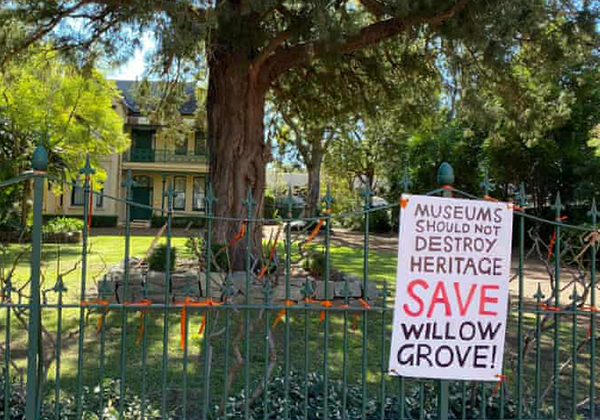No construction work can begin on Willow Grove until next Friday 2nd July, thanks to an injunction filed on Tuesday afternoon. There will be an appeal hearing on this date to determine whether The North Parramatta Residents Action Group (NPRAG) v Infrastructure NSW case will be decided in the Supreme Court.
Today, the NSW government unsuccessfully tried to appeal the injunction in order to begin work on the site. This latest development comes after an eventful two weeks for the 130-year-old heritage building, set to be relocated for the construction of the Powerhouse Museum Parramatta.
On 16th June, the Land and Environment Court ruled in favour of Infrastructure NSW, giving the government permission to relocate Willow Grove to an as yet undecided site. The NPRAG had taken the government to court in March, arguing they had failed to consider alternate sites for the museum.
The Construction, Forestry, Maritime, Mining and Energy Union (CFMMEU) has been enacting a Green Ban on Willow Grove since June 2020, effectively saving it from demolition. They have vowed to continue the ban regardless of the result. A green ban is a form of strike action where members of a trade union refuse to work on a project because of environmental or heritage concerns.
On 6:00PM Tuesday, 21st June, government contractors entered Willow Grove with ladders and tools to begin construction work, in an action NPRAG spokesperson Suzette Meade described as a “low dog act on the community in Parramatta and an underhanded move by Heartless (Don) Harwin.”
A snap community picket was called in response, with well over a hundred union and community members arriving promptly to block all entrances to the building. They remained there for nearly 24 hours until the NPRAG lodged their appeal and received an injunction, preventing further work on the site as of 22nd June.

So long as the green ban remains in place, it is difficult to determine what will happen next.
If the government wins at the Supreme Court they will still find it challenging to relocate the building. CFMMEU union members are keeping Willow Grove under 24-hour surveillance and NSW CFMMEU secretary Darren Greenfield says the union’s members will tie themselves to bulldozers to prevent its removal.
Moreover, according to Greenfield, the CFMMEU has sway over non-union members. In an interview with morning talk-show host Ray Hadley, Greenfield explained that the CFMMEU was “not too concerned” by the prospect of strike-breakers, because they generally listen to the unions once the reasons behind green bans are explained.
As for the government, it is difficult to ascertain how far they are willing to go. There has been a history of backflips since former premier Mike Baird first proposed to relocate the Powerhouse museum from Ultimo to Parramatta in 2015. The original plan was to sell the Ultimo site to property developers for a sum of up to $200 million, with the money going towards building the new museum.
However, the government reversed that decision in July last year, after coming under criticism for planning to disperse the Powerhouse’s industrial heritage collection to regional museums. Earlier this month, the government also announced it would inject $500 million into the Powerhouse Museum in Ultimo as part of a major revamp. This is the state’s largest investment in a cultural institution since the Opera House and brings the cost of the project to $1.4 billion.
Minister for the Arts Don Harwin has indicated the government could purchase adjacent sites to Willow Grove, thus keeping the heritage building in its original location. However, he has argued against such a move because it would cost more and negatively impact the original design. Yet considering how much the government has already spent on the project, finances do not appear to be the main issue. As to the argument that purchasing sites adjacent to Willow Grove would negatively impact the design of the Powerhouse, Harwin was approached for comment but did not respond.
The NSW Coalition government say they are determined for Western Sydney to get a world class museum and claim that the public are overwhelmingly behind them. However, the NPRAG, who also want Parramatta to get a world class museum, argue the government should look at alternate sites to the riverbank, notably the Cumberland Hospital East Precinct, which they argue is bigger and more accessible. The NPRAG also claims widespread popular support for this proposal.
Indeed, Parramatta City Council have passed two unanimous motions calling for Willow Grove to be retained in the Powerhouse Museum Parramatta’s design. Additionally, the government’s Environmental Impact Statement issued last year attracted over 1600 submissions, with over 90% of them arguing against removing Willow Grove.
Willow Grove was built in 1891 on the banks of the Parramatta River on Dharug land. It is the only example of Victorian Italianate architecture in the Parramatta CBD. The villa has a history of women’s entrepreneurship and Indigenous association. It was built as a private residence by haberdashery owner Annie Gallagher in 1891 and then became a maternity ward from 1920-53.
Gallagher was one of the few landowners that allowed the local Dharug people access to the site for fishing. It also did not exclude Indigenous women when it operated as a maternity ward. The Dharug Strategic Management Group, a local Aboriginal organisation, describes Willow Grove as one of the only historical buildings in Parramatta without a legacy of colonial violence.
Heritage experts and architects have expressed doubt as to whether Willow Grove can be dismantled and reassembled, given the age of its materials. The National Trust argue that “very little” of the building’s original fabric could survive a relocation, “no matter how carefully done.”





